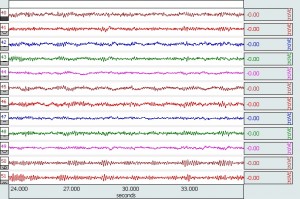New Features and Enhancements Increase the Power & Flexibility of AcqKnowledge! AcqKnowledge software is included with each MP160 and MP36R System and some integrated systems; it can also be purchased separately. Check BIOPAC…
Search
When performing some experiments, it may be desirable to link a recorded audio file to a recorded data file. For instance, a subject may be speaking, listening to voice commands,…
A band pass filter allows the energy concentrated between two given frequencies (X and Y) to pass while it attenuates the signal's energy at other frequencies. It is equivalent to…
If a BioNomadix wireless physiology signal displays dropout/flatline… On a single channel Make sure transducer/lead is firmly inserted to transmitter channel, electrodes are fully adhered, and leads are not pulling…
Biopac Student Lab (BSL) integrated hardware, software, and curriculum systems allow students to record data from their own bodies, animal, or tissue preps to learn principles of life science physiology.…
To record bipolar EEG, you will need an EEG amplifier for each pair of electrodes that you want to calculate the potential difference between. It is important to note that…
Make sure the unit is turned on and connected to the computer. Check for the green circular icon next to the Start button, which indicates that the unit is connected…
AcqKnowledge includes digital filters that allow you to filter a raw EEG into the following frequency bands: Delta 0.5-4Hz Theta 4-8Hz Alpha 8-13Hz Beta 13-30Hz Gamma 36-90Hz (in some older…
Reference corresponds to the VIN- connection on EEG amplifiers; on the MP3X, if using the SS1LA lead adapter, VIN- is on the lead adapter. Use each ear as a reference…
The “Electrode Check” port on the front panel of MP36 and MP35 units is dseigned to measure impedance. As a rule of thumb, impedance levels below 10 kOhms are ideal,…
Q: What’s being measured? Q: Areas potentially available for study? Q: Response times? Q: BNC Trigger delay? Q: Placement guidelines for sensor? Q: Strengths and limitations of fNIRS? Q: Identify…
The terminology for electrical connections to human subjects is not universally agreed upon. “Ground” and “reference” are often used interchangeably. This is not a good practice as there are different…
When a single subject is connected via wires to a single MP system, there should generally be one and only one ground connection to that subject*. When multiple subject grounds are…
PRINT-FRIENDLY PDF Head mounted displays (HMD) are often utilized in virtual reality protocols. Measures such as fNIRS, EEG, and Cognitive State are also useful, and sensors for such measurements must…
Sometimes algorithms designed to locate ECG complex boundaries place QRS peak event marks at the wrong locations, such as: While it is not possible to wholesale move event marks when…
There are many possible reasons for a flat signal. It is important to make a distinction between the data (the numbers that the computer is actually recording) and the display…
Transducers developed by BIOPAC are linear over their expected ranges of operation. Therefore, knowing the system’s response to two physical stimuli is all that is required. In many cases the…
If your installation CD or DVD for BIOPAC Software—AcqKnowledge, Biopac Student Lab, Biopac Science Lab—is lost or damaged and you need to re-install the software, please send an e-mail to support@biopac.com.with…
If you are using a single MP100/MP150 system, the maximum number of EEG amplifiers you can have is 16. If more channels are required, it is possible to link acquisitions from…
Sample rates for physiological signals acquired by the MP40 Biopac Science Lab system: ECG 1000 EMG 1000 EOG 250 EEG 250 RESPIRATION 500
BIOPAC offers a series of magnetic resonance imaging compatible electrodes, electrode leads, transducers, and stimulus options for safe data acquisition of physiological signals in the MRI environment. Specialized cable systems…
BIOPAC definitions Items have been tested with a 7T Siemens MAGNETOM, with SC72 gradient set, a maximum gradient amplitude of 70 mT/m, and a slew rate of 200 mT/m/ms. Tested…
A notch filter is typically an aggressive filter that strongly attenuates the power over a narrow region of the spectrum. For example, a notch filter at 60 Hz / 50 Hz is…
Commonly performed life science measurements are listed below by name and acronym. BIOPAC has data acquisition and analysis solutions for all of these and many more…contact support@biopac.com with a specfic…
When using electrodes: Prepare the electrode site by removing dead skin—unless recording EDA/GSR—using an ELPAD and cotton swabs with water. If recording EDA/GSR, see EDA (GSR) subject preparation for guidelines.…
On the MP100/MP150: For unipolar recording you need as many amplifiers as you have sites to record from. For example, for 16 electrodes (not including 1 reference and 1 ground),…
EEG: Electroencephalography

Surface and Implanted EEG Solutions
BIOPAC® provides a wide range of tools for recording, displaying, and analyzing surface EEG (sEEG) and implanted EEG signals from human and animal subjects. BIOPAC® offers a number of hardware solutions that allow you to record from a single channel of EEG and up to 32 channels of wireless and logged data. There are also hardware options available for full-band EEG (FbEEG) recordings with bandwidths from DC to hundreds of Hz. EEG Systems are available for in lab recordings, real-world applications, small animal wireless recordings, and MRI applications. Advanced real-time analysis options provide metrics for subject engagement, workload and drowsiness.
Stay Connected